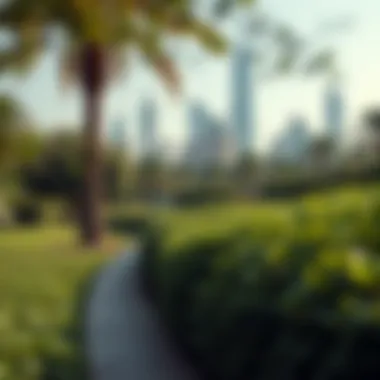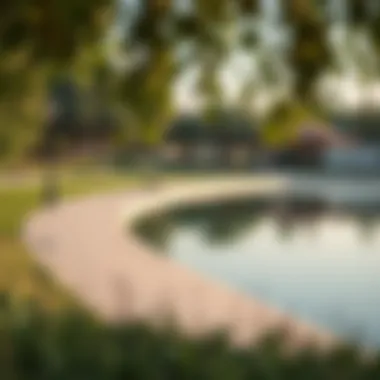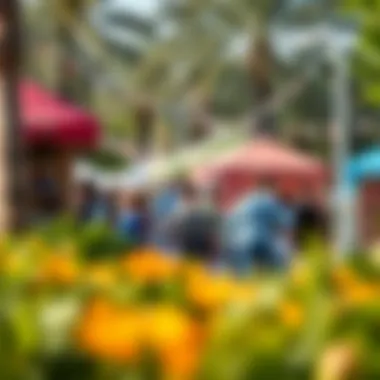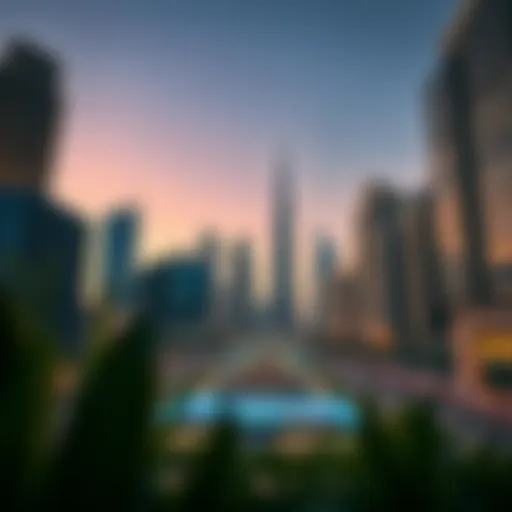Discovering Dubai's Urban Parks: Green Oases in the City


Intro
Dubai, often synonymous with dazzling skyscrapers and bustling urban life, holds within its borders an enchanting collection of parks that serve as tranquil havens for residents and visitors. The influence of rapid urbanization has bred an essential need for green spaces, acting as vital lungs in the heart of a city teeming with life. These parks not only enhance the aesthetic appeal of the urban landscape but also play a crucial role in fostering community connectivity and promoting environmental sustainability.
As the city evolves, so do the expectations surrounding public spaces. This exploration delves into the welcoming arms of Dubai’s parks, shedding light on the diverse offerings available—from extensive recreational facilities to serene picnic spots. Parks such as Safa Park, Al Barsha Pond Park, and the newly inaugurated Dubai Parks and Resorts embody the city’s commitment to creating an integrated, holistic environment that prioritizes quality of life.
In this narrative, we will unearth what makes these green spaces more than just patches of grass among buildings. We will examine the intricate balance they maintain between urban living and nature, address the various recreational options available to residents and tourists, and explore how these parks foster community spirit. Join us as we traverse this verdant landscape and appreciate the relief these parks provide amid the clamor of urban existence.
Intro to Dubai’s Green Spaces
In the heart of a bustling metropolis like Dubai, where towering skyscrapers dominate the skyline, the presence of lush green spaces offers a refreshing contrast to the granite and glass that envelops city life. These parks act not just as pockets of nature, but as vital components of the urban ecosystem, contributing significantly to the quality of life for residents and visitors alike.
Parks in Dubai serve multiple purposes, from recreational areas where families can gather, to tranquil spots that provide a much-needed escape from the relentless pace of urban living. The importance of these spaces extends beyond leisure; they play a crucial role in promoting mental well-being, encouraging social interaction, and even supporting environmental sustainability.
Benefits of Green Spaces:
- Mental Health: Scientific studies show that spending time in nature has positive effects on mental health, reducing stress and enhancing mood.
- Community Engagement: Parks act as social equalizers, bridging gaps between social classes and fostering a sense of unity among diverse populations.
- Environmental Impact: Urban greenery helps in cooling the surroundings, reducing pollution, and creating habitats for various species.
Moreover, the city’s commitment to environmental conservation is exemplified by its ongoing initiatives to integrate more green spaces into urban planning. With climate change posing significant challenges, these parks are becoming increasingly relevant. They not only enhance biodiversity but also contribute to sustainability efforts that are essential for the enduring health of the metropolitan area.
As we explore Dubai's parks in this article, we will delve into their historical context, examine key parks, and discuss the role they play in community life and urban planning. Each park tells a unique story, reflecting the cultural and architectural evolution of the city while providing a natural retreat amidst the urban chaos. This exploration will reveal how these green oases are essential for enhancing the overall ambiance of Dubai, making it a more livable and attractive place for both residents and tourists.
"Green spaces are the lungs of the city, breathing life into an otherwise concrete landscape."
Ultimately, understanding Dubai’s green spaces allows us to appreciate their role not just as recreational areas, but as indispensable elements of the urban fabric that promote health, community interaction, and ecological sustainability.
Historical Context of Parks in Dubai
Understanding the historical context of parks in Dubai is crucial for grasping the evolution of its urban landscape. As the city transformed from a humble fishing village into a thriving metropolis, the need for green spaces became increasingly important. These parks are not merely patches of grass in a desert; they represent a significant cultural and social investment aimed at enriching the lives of its residents and visitors.
Evolution of Urban Greenery
The journey of urban greenery in Dubai took root as the city began to influence global trends while maintaining its unique cultural heritage. In the late 20th century, before the concrete jungle took hold, Dubai’s minimal landscaping reflected its natural desert environment. However, as the population swelled and urbanization accelerated, the landscape began to change. Government initiatives in the 1990s, particularly the introduction of parks, represented a clear acknowledgment of the need for recreational spaces.
These developments were not just afterthoughts; they were meticulously planned spaces that prioritized beauty and functionality. Parks such as Dubai Creek Park were among the first to be established, serving as a prototype for future green spaces. The greenery of these areas plays a vital role in improving air quality, offering respite from the intense climate, and providing a sanctuary for residents seeking leisure and social interaction.
The evolution is also linked to broader global movements towards environmental sustainability. This has seen Dubai adopt practices that integrate advanced irrigation techniques and native plantings to ensure that these oases thrive within their urban context.
Cultural Significance of Parks
Parks in Dubai carry more than just aesthetic appeal; they weave cultural narratives that enhance community life. Historically, these venues have served as gathering places, where families come together, children play, and festivals are celebrated. Parks embody a social fabric, a canvas where traditions meet communities. For instance, events during the UAE National Day often see many parks bustling with activity, showcasing the cultural heritage through music, dance, and food.
Parks in Dubai are social equalizers, cutting across demographic boundaries, inviting all residents—locals and expatriates alike—to share experiences and create lasting bonds.
Additionally, these green spaces offer vital opportunities for education around environmental conservation and sustainability. Workshops, nature trails, and community gardens allow residents to engage with nature, fostering a sense of stewardship for their surroundings. The local flora and fauna found in parks not only beautify the area but also serve educational purposes, illustrating the importance of biodiversity in an otherwise urban-centric environment.
In summary, the historical context of parks in Dubai reveals their evolution as vital components of urban planning. The transformation of Dubai’s parks reflects societal values, aspirations, and the pressing need for green retreats in a landscape dominated by skyscrapers. As the city continues to grow, the interplay between urban development and green spaces will remain a pivotal aspect of its future.
Key Parks in Dubai
Dubai is often synonymous with glamour and skyscrapers, but it also boasts an impressive array of parks, which are not just patches of greenery but vital parts of the city's urban ecosystem. These parks serve as a necessary break from the urban hustle, providing residents and visitors a space to breathe, relax, and connect with nature. Their importance stems from facilitating social interaction, promoting physical well-being, and offering an overall enhancement to the quality of life in one of the busiest cities in the world. Exploring these parks allows us to appreciate how thoughtful urban planning integrates nature into busy lifestyles, transforming city dwellers' views on recreation and community engagement.
Dubai Creek Park
Features and Amenities
Dubai Creek Park stands out as one of the largest parks in the city, sprawling over 96 hectares along the banks of the historic creek. Its features include vast green lawns, family-friendly areas, and dedicated spaces for sports. A notable aspect is the park's amphitheater, which hosts concerts and cultural events throughout the year. This park is popular for offering a variety of leisure activities that engage both the young and the elderly. Its well-maintained walking paths and playgrounds cater to families, making it an attractive option for weekend outings.
Visitor Experience


The visitor experience at Dubai Creek Park reflects a harmonious blend of relaxation and activity. Many find enjoyment in picnics, jogging, or cycling along picturesque trails while being surrounded by well-tended landscapes. Unique to the park is an old-fashioned ride on the creek, providing a slower glimpse of the city’s vibrant life. However, it can become crowded, especially during weekends and public holidays, which may detract from a peaceful visit. Still, this park's array of attractions keeps visitors coming back.
Accessibility
Accessibility is another major highlight of Dubai Creek Park. Positioned near several major roads, it's easy to reach by car or public transport. The park features ample parking space and well-maintained footpaths, making it navigable for those with mobility challenges. However, certain areas might not be adequately paved, limiting access in parts. Overall, the convenience of getting there enhances its popularity among both locals and tourists.
Zabeel Park
Overview of Facilities
Zabeel Park is an oasis tucked amidst the concrete of Dubai, showcasing a mix of facilities that appeal to a wide range of visitors. It includes a dedicated area for children’s play, a cycling track, and barbecue spots for family gatherings. This park is remarkable for its engineering marvels, such as the Dubai Frame that offers stunning views of the city. The diversity of facilities fosters a sense of community, inviting people to experience various activities in a single location.
Activities Available
From exploring the park's botanical gardens to enjoying various sports—like football and cricket—Zabeel Park caters to diverse interests. Regular events such as art exhibitions and seasonal festivals add to the excitement. Folks often find themselves engaged in picnics or leisurely strolls while soaking up the sun. The wide range of activities ensures that there's something for everyone, making it a highly desirable destination for leisure and socializing.
Importance in Community Engagement
Zabeel Park plays a pivotal role in community engagement, serving as a venue for public events that encourage interaction among residents. Events range from fitness classes to cultural festivities, effectively uniting diverse groups under its vast green canopy. The park's inclusive design fosters friendships and strengthens community ties. However, it can sometimes feel overwhelming during large gatherings, which may deter those seeking quieter moments.
Safa Park
Natural Beauty and Design
Safa Park is renowned for its stunning landscaping, characterized by lush greenery and tranquil water features. This park's tranquil environment offers an escape from Dubai's bustling life. Visitors are constantly impressed by its thoughtful design, which incorporates natural elements to create a peaceful ambiance. It serves as a visual treat and boosts mental well-being by providing a serene backdrop for relaxation and reflection.
Proximity to Urban Areas
Safa Park's strategic location near major roads and urban centers enhances its appeal. Residents living in nearby districts can easily access the park, making it a popular spot for unwinding after a long day. Many people consider it a perfect blend of nature and convenience. However, its popularity brings challenges, as it can become crowded during peak times, reducing the tranquility that many seek.
Public Events and Activities
Safa Park hosts a variety of public events, from fitness programs to art exhibitions that engage the local community. Its event calendar attracts many to participate in outdoor activities, encouraging them to embrace a healthier lifestyle. The park's capability to act as a venue for community activities ensures ongoing visitor interest and proves vital to Dubai's social fabric. Occasionally, however, the influx of visitors during major events can lead to overcrowding, potentially diminishing the enjoyment of those looking for a peaceful retreat.
The Role of Parks in Urban Planning
The integration of parks within urban planning is not merely an aesthetic choice; it's a foundational aspect that enriches city life. Parks serve as the lungs of the city, offering relief from the concrete jungle and promoting a healthier lifestyle for all residents. They help harmonize the often chaotic urban environment and provide much-needed spaces for relaxation, recreation, and socialization. In Dubai, the development and design of parks reflect an understanding of the delicate balance between urban development and nature. As the city continues to expand, parks also become key environmental assets for maintaining sustainability and enhancing quality of life.
Integrating Nature in Urban Design
Strategies for Sustainable Development
One significant aspect of integrating nature into urban design is by adopting strategies for sustainable development. These strategies are crucial in creating green infrastructure that enhances urban environments while conserving natural resources. Designing parks with native plant species not only promotes biodiversity but also reduces maintenance costs and water usage.
Unique features include:
- Rain gardens that absorb rainwater and mitigate flooding.
- Wildlife corridors that encourage local fauna to thrive within urban settings.
- Community gardens that allow residents to engage with nature while promoting local food sources.
These elements work together, ensuring that parks are not just a luxury but a necessity in modern urban landscapes. However, the challenge remains in securing funding and community engagement for such initiatives.
Benefits of Green Spaces in Urban Settings
Green spaces bring a plethora of benefits to urban settings, significantly contributing to social well-being and environmental health. The most notable characteristic of these benefits is their capacity to improve mental health and social cohesion. Studies suggest that areas abundant with green spaces lower stress levels and foster community ties among residents.
Key advantages include:
- Reduction in urban heat: Parks act as cooling pockets, reducing ambient temperature in nearby areas.
- Enhanced air quality: Trees and vegetation filter pollutants, contributing to healthier urban environments.
- Physical health benefits: Parks encourage outdoor activities, leading to more active lifestyles among residents.
These benefits underscore why green spaces are a key consideration in urban planning. Nevertheless, ensuring equitable access to these parks remains a challenge, as disparities in park distribution can exist.
Parks as Community Hubs


Social Interaction
Parks play a vital role in promoting social interaction among diverse community members. They serve as gathering points where individuals from different backgrounds can come together, fostering a sense of belonging. Community events held in these parks, such as festivals and sports competitions, further enhance the social fabric of neighborhoods.
A unique feature of parks facilitating social interaction is their ability to create multi-functional spaces that cater to various age groups and interests. For example, playgrounds for children, fitness stations for adults, and quiet zones for the elderly ensure that everyone has a place to feel included. However, it often requires proactive efforts from city planners and community organizers to cultivate an inviting atmosphere.
Inclusive Spaces for All Ages
Designing parks as inclusive spaces for all ages is essential in fostering community synergy. A key characteristic of successful parks is their accessibility and adaptability, accommodating individuals from different demographics. By incorporating elements such as wheelchair-friendly paths, sensory gardens for individuals with disabilities, and playgrounds designed for children with various needs, parks can cater to a broad audience.
Advantages include:
- Promoting engagement: By offering activities suitable for children, adults, and seniors, community engagement increases.
- Innovative design solutions: Parks can utilize universal design principles that ensure that every person can enjoy and access these green spaces without limitations.
However, realizing these aims does pose challenges, mainly in balancing budget constraints with the desire for inclusivity. As Dubai continues to develop, the role of parks as community hubs becomes ever more crucial.
Visitor Insights and Experiences
Understanding how people engage with parks is core to grasping their value in an urban setting like Dubai. This section shines a spotlight on visitor insights and experiences, setting the tone for how effective these green spaces are at promoting well-being and community bonding. The way individuals experience parks, whether as a breath of fresh air or a hub of activity, reflects their significance in enhancing the quality of life amidst city hustle. The feedback gathered from various groups underscores the parks' pivotal role in not only providing greenery but also fostering connections among users, both local and visiting.
Demographics of Park Visitors
Local Residents
Local residents constitute a significant segment of park visitors. They come for a variety of reasons that enrich both their personal lives and the community as a whole. A key characteristic of these visitors is their familiarity with local amenities; they often utilize parks for daily activities such as jogging, picnicking, or social gatherings. This regular patronage helps in cultivating a sense of ownership over these spaces, making parks an extension of their living environment.
The unique feature of local visitors lies in their diverse backgrounds, which contributes to a rich tapestry of interactions within the park setting. They are typically seen engaging in community events or using facilities like basketball courts and playgrounds, which fosters social ties and community bonding. One advantageous aspect of local resident engagement is the continuity of presence, which enhances the safety and vibrancy of the parks. However, challenges do exist; overcrowding at peak times can detract from the overall experience, possibly leading to conflicts over space.
Tourists and Their Preferences
Tourists come to Dubai's parks with distinct expectations and preferences, aiming to enjoy a slice of the city's unique charm and greenery before heading off to more traditional tourist attractions. A standout feature of these visitors is their desire for experiences that combine leisure with photography, often seeking picturesque spots to capture the essence of their visit. This inclination not only invigorates the park ambiance but also elevates its profile as an international destination.
However, tourists may prioritize different park experiences compared to locals. They might prefer guided tours, engaging in casual strolls while soaking up local culture or stopping by food stalls offering regional delicacies. While these experiences undoubtedly benefit park visibility, they often pose a challenge in terms of maintaining balance between varied visitor needs. Adequately catering to tourists while keeping local residents satisfied is vital for the parks’ long-term success.
Feedback on Park Facilities
Strengths and Weaknesses
In assessing park facilities, it’s crucial to understand both strengths and weaknesses from the perspective of visitors. A predominant strength identified through feedback is the abundance of well-maintained amenities such as sports fields, walking paths, and children's playgrounds. Many visitors express appreciation for cleanliness and accessibility, which contribute positively to their experiences.
However, weaknesses do surface; certain parks may lack sufficient seating areas or shaded spaces that can make visits uncomfortable on hot days. Often, the layout is not intuitive, leading visitors to spend more time navigating than enjoying their time outdoors. Finding a balance between facilities that cater to recreational needs and ensuring the ambiance of the parks feels inviting is essential for improvement.
Areas for Improvement
The insights on areas for improvement mostly highlight the need for continual investment in park infrastructure. One common piece of feedback is the desire for enhanced connectivity between parks and nearby urban areas. This can mean better public transport options or pedestrian pathways that make it easier for visitors to move around the city and enjoy multiple parks in one outing.
Additionally, the aspect of visitor amenities cannot be overstated. Suggestions include the installation of more modern restroom facilities, water stations, and even informational signage about park programs and flora. These enhancements not only improve visitor satisfaction but also reinforce the parks' role as vital community resources.
Environmental Considerations
Dubai, a city that intertwines modern architecture with natural elements, faces unique environmental challenges. This section pertains to how the parks are not merely recreational spaces but pivotal in shaping the ecological landscape of the urban environment. The significance of parks in Dubai extends to climate adaptation and conservation efforts that aim to mitigate the adverse impacts of urbanization.
Parks and Climate Adaptation
Role in Urban Cooling
The role that parks play in urban cooling cannot be overstated. In Dubai's intense heat, greenery in parks offers a natural remedy to combat high temperatures. Trees and plants act as natural air conditioners, providing shade and reducing heat through evapotranspiration. One beneficial aspect of this is that cities like Dubai end up creating localized cooler microclimates. This is particularly important when you think about urban planning in regions that often swelter under the relentless sun.
A unique characteristic of the cooling effect is its ability to lower energy consumption in nearby buildings, which can significantly reduce air conditioning costs – a relief for local businesses and residents alike. Furthermore, well-planned park areas can reduce the urban heat island effect, making them not just a leisure spot but essential for the climate resilience of the city.
Biodiversity Conservation


Biodiversity conservation holds great importance in urban settings like Dubai, where green spaces provide habitats for various flora and fauna. Parks serve as critical biodiversity hotspots that foster ecosystems right in the heart of the city. This aspect underscores the ongoing commitment to weave nature into urban life, encouraging a balance between development and preservation.
Key to this is the encouragement of urban wildlife, which benefits overall ecosystem processes. Unique features, like native plant gardens within parks, serve the dual purpose of preserving local species while offering educational experiences for visitors. However, maintaining biodiversity can be challenging due to overdevelopment and pollution. Thus, parks serve not only as recreational spaces but as sanctuaries for species that might otherwise struggle in urban environments.
Sustainable Practices in Park Maintenance
Water Management
Water management is a crucial element in maintaining parks effectively in Dubai's arid climate. Sustainable irrigation practices, such as drip irrigation and rainwater harvesting, are increasingly being adopted. This method not only ensures that plants receive the necessary hydration but also cuts down on wastage, proving to be an environmentally sound strategy for preserving water in a water-scarce region.
The benefit here lies in the sustainable use of a precious resource while promoting green growth. Yet, efforts to manage water wisely face challenges, particularly with increasing demand and global climate shifts, making an adaptable water management approach essential.
Waste Reduction Strategies
Waste reduction strategies are vital for the sustainable upkeep of parks in Dubai. This includes recycling programs and composting organic matter from park maintenance to reduce landfill waste. Such strategies, when integrated into the park's operations, can minimize the environmental footprint and create a cleaner, healthier locale for everyone.
An interesting feature of these practices is community involvement, which often arises through awareness campaigns. Engaging local residents and school groups in recycling efforts can foster a culture of sustainability while improving the park's ambiance. The drawback, however, remains in ensuring consistent participation from the community, highlighting the need for continuous efforts in education and outreach.
Future Developments and Innovations
As Dubai continues to evolve, so do its parks. The future of urban greenery promises not only to enhance the aesthetic appeal of the metropolis but also to cater to the needs of its growing population. This section explores emerging trends and projects that are set to redefine the green spaces of Dubai, highlighting community involvement and cutting-edge technology in park management.
Emerging Park Projects
Proposed Green Spaces
Proposed green spaces in Dubai are not just about adding more patches of green to the concrete jungle; they represent a holistic approach to urban development. These parks aim to create respite from the city's rapid pace while fostering biodiversity. One noteworthy project is the Dubai Marina Green Corridor, designed to connect multiple parks along the waterfront. This corridor boasts features such as walking trails, playgrounds, and dedicated areas for local flora. Such parks bolster community well-being by providing accessible recreation options in an often bustling environment.
Moreover, they serve to absorb excess carbon emissions, acting as natural air filters—a major advantage in ongoing discussions surrounding climate change and urban living.
"Proposed green spaces are key to reshaping Dubai's urban narrative, putting nature back into the heart of the city."
Community Involvement in Design
When it comes to community involvement in design, it is not just a buzzword; it’s at the core of creating spaces that resonate with the locals. The Vision 2040 plan emphasizes co-designing parks and green spaces with residents, ensuring that their voices are heard. The advantage of engaging the community lies in tailoring those spaces to fit their needs, whether that’s quiet reflection zones, fitness circuits, or social gathering spots.
Unique features of this initiative include workshops and public forums where residents can express ideas and preferences, fostering a sense of ownership. Despite its triumphs, challenges remain, particularly in balancing diverse opinions to create universally enjoyable spaces.
Technology in Park Management
Smart Park Features
As the world becomes more tech-savvy, so too do the features of Dubai’s parks. Smart park features include Wi-Fi hotspots, interactive information kiosks, and even air quality monitoring stations. An example is the Mushrif Park which implements smart lighting and automated irrigation systems that adjust based on weather conditions. These technologies are beneficial as they not only enhance visitor experience but also promote sustainability by conserving resources and reducing energy use.
However, the challenge here lies in the need for ongoing maintenance and updates to keep the technology relevant and functional.
Visitor Engagement through Digital Platforms
Engagement through digital platforms offers a fresh take on park experiences. Mobile applications and websites can provide real-time information on events, park safety guidelines, and even flora and fauna present in the parks. The Dubai Parks app is a perfect illustration, showcasing not only details of park facilities but also allowing users to book space for events and activities.
This digital integration ensures a higher level of interaction and custodianship among visitors, making them more inclined to participate in events and voice their thoughts on park usage. A disadvantage some might point to is the potential tech disparity amongst visitors; not everyone might be tech-savvy, which could deter engagement.
In summary, the future of parks in Dubai is looking bright with ambitious projects and innovative technological applications designed to enhance experiences while promoting sustainability. Community involvement remains a critical factor in ensuring these spaces meet public demands and contribute meaningfully to urban life.
End
In wrapping up our exploration of Dubai's parks, it becomes clear that these green spaces hold much more than mere trees and grass. They represent a fundamental shift in urban planning and community life, offering a sanctuary amidst the hustle and bustle of a bustling metropolis. Parks are not just a luxury; they are a necessity, creating vital refuges for residents and tourists alike.
The role of parks in enhancing the quality of life cannot be overstated. By incorporating nature into the cityscape, these areas facilitate leisure, recreational activities, and social interactions. They serve as a meeting ground for diverse populations, bridging cultural divides through shared experiences. Engaging in community events or simply enjoying leisurely strolls, people foster friendships and a sense of belonging, laying the groundwork for a cohesive community. This social fabric is essential for an urban area often defined by its rapid growth and change.
Moreover, the environmental implications of these parks are significant. They work as urban lungs, supporting biodiversity and helping to mitigate the effects of climate change. This dual role of social and environmental importance makes it necessary for ongoing investment and development in these green spaces. Investors and real estate professionals should take note: properties near well-maintained parks often see a boost in appeal and value. It’s a win-win scenario, benefitting both the community and the economy.
Ultimately, this article serves to shine a light on how essential parks are within the context of Dubai’s evolving urban landscape. As the city continues to grow, fostering a commitment to green spaces will be crucial for sustaining its appeal and ensuring a high quality of life for all its residents.
"Parks are not mere facilities; they are vital components of community identity and resilience."
By recognizing and investing in these urban oases, we are investing in the future of Dubai as not only a city of innovation but also a city of community and sustainability.















